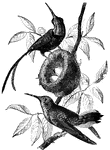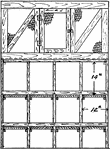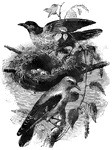
Legs of the Hive Bee
Honey bees (or honeybees) are a subset of bees, primarily distinguished by the production and storage…

Honey Bee (Male)
Honey bees (or honeybees) are a subset of bees, primarily distinguished by the production and storage…

Honey Bee (Queen)
Honey bees (or honeybees) are a subset of bees, primarily distinguished by the production and storage…

Honey Bee (Worker)
Honey bees (or honeybees) are a subset of bees, primarily distinguished by the production and storage…

Legs of the Humble Bee
A bumblebee (or bumble bee) is any member of the bee genus Bombus, in the family Apidae. Pictured here…

Mason Bee
"The Mason Bee, Osmia, of which there are many kinds, makes its cells in spaces from which…

Legs of the Stingless Bee
Stingless bees, or simply meliponines, are a large group of bees, comprising the tribe Meliponini in…

Working Bees
""The working bee, for collecting wax, enters a flower, the stamens of which are loaded with pollen.…
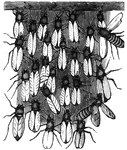
Bees Secreting Wax
"The secretion of wax, it would appear, goes on best when the bees are in a state of repose, and the…

Cells of Honey Bees
"The hexagonal cells for the honey are build upon precisely that mathematical angle which affords the…

Nest of Tailor-Bird
"The nest of the Tailor-Bird is placed in a large leaf, the margins of which are sewn together, so as…

Nest of the Carder Bee
"The elevation of the dome, which is all built from the interior, is from four to six inches above the…

Nests of the genus Euplectes
Woven of grass, the nests of the genus Euplectes have an opening which faces down towards the water.…
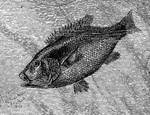
Hussar Fish
An illustration of the Hussar fish which is nest building fish which can be found in the Sea of Galilee.…

Graeco-Italic Foliated Shaft
The Graeco-Italic foliated shaft is a lamp-stand made out of bronze. It is a design that is inspired…

Great Crested Grebe
The Great Crested Grebe (Lophæthyia cristata) is a fresh-water, migratory, diving bird of the family…

honey-comb
"The comb is made of wax, found in various plants, but which is also secreted by the bees themselves…

Hornets and Nest
"The Hornets resemble the Wasps in their habits, but but they are noted for their spitefulness and the…

Interior of the Humble-Bee's Nest
"The Humble-bees, or as they are often called in this country, the Bumble-bees are…

Hussar Fish and Young
An illustration of the Hussar fish which is nest building fish which can be found in the Sea of Galilee.…

European Kite
European Kites are very miscellaneous feeders, but depend largely on offal, and in the eastern tropics…

Lapwing (or Peewit)
A handsome plover-like bird of Northern Europe and Asia (Vanellus cristatus), also known in Great Britain…

Mockingbirds Attacking a Rattlesnake
A flock of mocking-birds attacking a rattlesnake in a tree, which was threatening a nest.

Phoebe's Nest
An illustration of a Phoebe's nest in a box. The genus Sayornis is a small group of medium-sized insect-eating…

Hornero Ovenbird
The horneo oven-bird, which builds its nest out of clay, straw, and dried vegetation.

Golden-Crested Regulus
Also known as the kinglet, the golden-crested regulus is found throughout Europe and is noted for its…

Common Skylark
The common skylark is a small bird of the passerine family Alaudidae. In all larks, the first toe has…

Nest of Sociable or Republican Birds
"For ingenious construction, instigated by affection for its progeny, there is nothing to compare to…

Spider, diving
"Another remarkable member of the Araneidae is the Diving Spider, Argyroneta aquatica, which…

Sticklebacks and Nest
"A few fish, however, form a sort of nest for the protection of their eggs and young; and in some instances,…

Nest of the Common European Swallow
Nest of the common European swallow, which can be found in old wells and mines, under the roofs of barns…

Esculent Swallow
The esculent swallow's nest is prized among the Chinese as a delicacy. It is native to many parts of…










